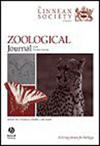Systematics of minute strabomantid frogs allocated to the genus Noblella (Amphibia: Anura) with description of a new genus, seven new species, and insights into historical biogeography
IF 2.8
2区 生物学
Q1 ZOOLOGY
引用次数: 0
Abstract
Noblella is a genus of 17 recognized nominal species of ground-dwelling, direct-developing frogs. It consists of two clades that do not form a monophyletic group: a northern clade from northern Peru, Ecuador, Colombia, and Brazil and a southern clade from southern Peru and Bolivia. Herein, we present a systematic review of Noblella with emphasis on the northern clade, including a new phylogeny based on DNA sequences of mitochondrial and nuclear genes. We also describe the osteology of five species from the northern clade using X-ray computed tomography. Based on our results, we resurrect the genus Phyllonastes for species of the northern clade (i.e. eight described species plus six new species described herein) and restrict the genus Noblella to the southern clade. We describe a new genus of Holoadeninae, sister to Phyllonastes: Urkuphryne gen. nov., from northern Ecuador. The new genus is distinguished by unique morphological characteristics that are diagnostic of different genera in Strabomantidae. We describe seven new species diagnosable based on morphology. Phyllonastes has five morphological synapomorphies, including the absence of vomerine teeth. Phyllonastes originated in the Pacific basin, Chocó region, ~21 Mya.两栖纲:无尾目)小蛙属系统分类学,新属7新种描述及历史生物地理学见解
Noblella属有17个已知的地栖、直接发育的蛙类物种。该属由两个支系组成,但这两个支系并不构成一个单系群:一个是来自秘鲁北部、厄瓜多尔、哥伦比亚和巴西的北部支系,另一个是来自秘鲁南部和玻利维亚的南部支系。在本文中,我们对 Noblella 进行了系统综述,重点介绍了北部支系,包括基于线粒体和核基因 DNA 序列的新系统发育。我们还利用 X 射线计算机断层扫描技术描述了北部支系五个物种的骨学特征。基于我们的研究结果,我们为北部支系的物种(即 8 个已描述的物种加上本文描述的 6 个新物种)恢复了 Phyllonastes 属,并将 Noblella 属限制在南部支系。我们描述了 Holoadeninae 的一个新属,它是 Phyllonastes 的姐妹属:Urkuphryne gen.该新属具有独特的形态特征,可诊断为Strabomantidae中的不同属。我们描述了七个可根据形态学诊断的新种。Phyllonastes有五个形态异形,包括没有绒毛齿。Phyllonastes起源于太平洋盆地的乔科地区,距今约2100万年。
本文章由计算机程序翻译,如有差异,请以英文原文为准。
求助全文
约1分钟内获得全文
求助全文
来源期刊
CiteScore
6.50
自引率
10.70%
发文量
116
审稿时长
6-12 weeks
期刊介绍:
The Zoological Journal of the Linnean Society publishes papers on systematic and evolutionary zoology and comparative, functional and other studies where relevant to these areas. Studies of extinct as well as living animals are included. Reviews are also published; these may be invited by the Editorial Board, but uninvited reviews may also be considered. The Zoological Journal also has a wide circulation amongst zoologists and although narrowly specialized papers are not excluded, potential authors should bear that readership in mind.

 求助内容:
求助内容: 应助结果提醒方式:
应助结果提醒方式:


